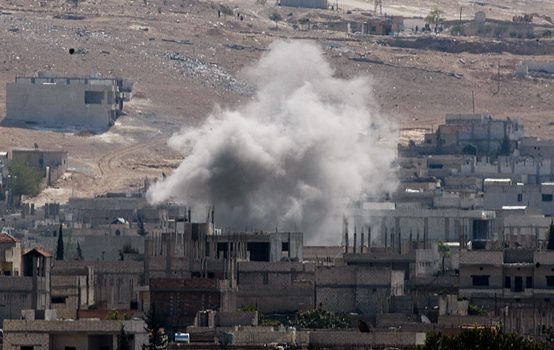Military Options Are Not the Same as Solutions

Recently, Obama Administration officials met to consider U.S. military options in Syria, Yemen, and Iraq. Should the U.S. conduct airstrikes against Syrian military targets? Or up the ante by arming anti-Assad rebels with more sophisticated weapons? Do we keep the USS Mason stationed off the coast of Yemen and continue missile strikes against targets in areas controlled by Houthi forces aligned with Iran—taking sides in a civil war and openly participating in the Saudi-led war in Yemen? And will more U.S. military support be needed to help Iraqi forces liberate Mosul from ISIS?
But none of these options are real solutions to the larger problems, which are political, economic, and social.
Conventional thinking is that military defeat will result in political acquiescence—as in the surrender of Germany and Japan in World War II. But we already know that doesn’t necessarily happen in the cauldron of the Middle East. The U.S. military fairly easily defeated Saddam Hussein’s military, but that did not result in a secure and stable country with the Iraqi people setting aside religious and cultural divisions to pursue a liberal democracy. Instead, Iraq continues to be a power struggle between the formerly oppressed majority Shiites and the minority Sunnis (and to a lesser degree, independence-minded Kurds). Our invasion also created a power vacuum that was filled first by al-Qaeda and now by ISIS. Soon we will see the next evolution of radical Islam.
So, for example, what if we are successful driving ISIS out of Mosul? Already we are concerned that the volatile mix of Kurdish peshmerga forces and Sunni and Shiite militias in a post-ISIS Mosul could trigger religious and ethnic conflict in the city. As often happens, we are likely to solve one problem only to face another, perhaps more difficult one.
The same is true in Syria. That the Obama Administration believes the result of regime change in Syria won’t look a whole lot like what happened in Iraq is, quite frankly, unbelievable.
You are supposed to learn from history and your own mistakes, not repeat them. Yet we are supposed to believe that if Bashar al-Assad is deposed, rebel groups will want to work together to build a peaceful, stable, democratic Syria based on a vision crafted in Washington; that they won’t, instead, engage in a power struggle; and that ISIS or some other terrorist group won’t fill the vacuum created by regime change.
In Yemen we find the reverse of the situation in Syria, with the U.S. wanting to keep the Hadi government in control and get the Houthi rebels to lay down their arms. But the only real military solution to insurgency is boots on the ground. The rule of thumb for successful counterinsurgency (largely practiced by the British) is 20 troops per 1,000 civilians. The population of Yemen is 24 million people, which means 480,000 troops—clearly a bridge too far.
Moreover, successful counterinsurgency requires the ruthless and relatively indiscriminate application of force to suppress violence and quell the opposition. Indeed, the British had to use such methods to crush the Mau Mau rebellion in Kenya in the 1950s. Yet that is exactly the last thing the U.S. should do in another Muslim country, as it would simply lend more credence to the radical Islamic narrative that the U.S. is waging a wider war against Muslims.
So U.S. naval missile strikes are not likely to have great strategic effect, and keeping the USS Mason stationed in the Red Sea within range of Houthi missiles only creates an inviting target.
But the larger issue for the U.S. in Syria, Iraq, and Yemen is that, however tragic the violence may be in these countries, it poses no direct threat to U.S. national security, which should be the guiding principle when Congress considers employing military force. And it should be Congress—not the president on his or her own—making these decisions.
Bashar al-Assad is a thug and threat to his own people, but the regime in Damascus does not pose a threat to American security. And our actions have succeeded only in prolonging that civil war and arming less-than-savory characters on various sides of this complicated tragedy.
ISIS is a threat within both Iraq and Syria, but not an existential threat to America—something President Obama and Rep. Duncan Hunter (R-Calif.) agree on. It is up to our strategic partners in the region—such as Turkey—to lead the fight. After all, they have more at stake and the most to lose by letting ISIS gain a stronghold. And in Yemen is a civil war that has no bearing on U.S. national security.
So rather than pondering military options in the White House, we should be asking what exactly we hope to achieve, how we plan to achieve it, how much it will cost, how long it will take, and how likely we are to succeed—and we should be asking those questions down Pennsylvania Avenue, in Congress.
Most importantly, however, we must understand that the use of U.S. military force is not the solution. The problems in Iraq, Syria, and Yemen will be solved only when those countries and their neighbors work together to craft a viable political solution.
Certainly, that won’t be easy. Nor will it likely happen quickly. But it cannot be imposed from the outside by U.S. military force. And whatever the solution, we must be willing to accept it, as long as it is not a direct threat to U.S. national security.
Charles V. Peña is a senior fellow with Defense Priorities. He is the former director of defense policy studies at the Cato Institute and author of Winning the Un-War: A New Strategy for the War on Terrorism.
Comments